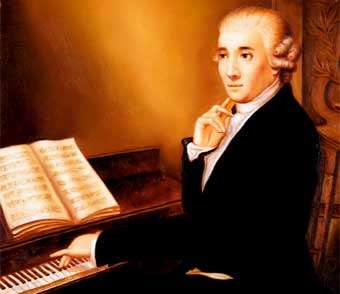Joseph Haydn

Joseph Haydn was a pioneering figure in Classical music. Haydn's parents noticed his talent at a young age, and sent him to live with a relative in Hainburg, where he could receive a good musical education. He was picked to be a boy soprano in Vienna's Cathedral of St. Steven. He worked there for a few years, and was promptly fired when his voice broke. Haydn freelanced for the next few years, getting attention in local orchestras. He finally earned a long term position at the court of Prince Paul Esterházy (and later for his brother and successor Nikolaus). Prince Esterházy's court spent half of every year in the countryside, which isolated Haydn from the musical mainstream for thirty years. This forced him to be very creative. He essentially invented the symphony and the string quartet. Even Mozart noted Haydn as a profound influence on his work.
- Call Back: The oratorio "The Seasons" has a moment where a plowman whistles while he works, and the tune he whistles is the melody from one of Haydn's own earlier hits.
- Ending Fatigue: Invoked in "String Quartet in E-Flat Major, Op. 33, No. 2" aka "The Joke", which sounds like a normal rondo until the end of the piece, when there's a grand pause. Then he starts the piece over, with one to three measures of silence between each phrase. This goes on for a while, and he finally ends it in the middle of a phrase. Audiences had no idea when to applaud, as the piece just kept going.
- Grave Robbing: An unfortunate Real Life example. Shortly after his death, Haydn's head was stolen for phrenological study. When his former patron found out, he demanded that the head be returned to its body. He had the thieves' houses searched, but they managed to hide it in a mattress. To complete the illusion, one of the thieves' wives lay on top of the skull and claimed menstruation, so the squicked-out searchers left rather than search the wife's room. Eventually, the thieves gave the Prince a skull. It was not Haydn's skull. A few generations and a string of inheritors later, Haydn's skull and body were reunited. In 1954.[1]
- Odd Friendship: Quiet, nature-loving family-man Haydn and brash, urban socialite Mozart.
- Scare Chord: Symphony No. 94, the "Surprise", features an unexpected fortissimo chord about 30 seconds into the otherwise quiet second movement.
- Starving Artist: Haydn was this for much of his youth.
- That's All Folks: Symphony No. 45, known as the "Farewell" Symphony - he and his musicians were kept at Prince Nikolaus Esterházy's summer palace much longer than expected, so at the end of the last movement, each musician stopped playing and left the stage, snuffing out their candle, until there were two violinists left. The prince got the hint and let them go the next day.
- ↑ Bizarrely, they did not remove the decoy skull when they placed Haydn's own skull in his coffin, so it now contains two skulls.